
by Matt Lollar | Mar 24, 2022

Written by: Donna Arnold, University of Florida/IFAS Extension – Gadsden County
Have you ever noticed mounds of dirt popping up on your lawn, in your cattle pastures, and other places? You just might be experiencing an ant invasion. The Red Imported Fire Ant, (referred to hereafter as RIFA) came from South America in the early 1900s through the port of Mobile, Alabama. Today, they have spread across the US and have become a serious pest causing significant social, environmental, and economic impacts. RIFA mounds can be seen in well-manicured landscapes, but also can nest around tree roots and stumps, as well as under pavement, buildings, and indoor areas. Although RIFA do prey on flea larvae, chinch bugs, cockroach eggs, ticks and other pests, however the problems they create usually outweigh their benefits.
Lifecycle/description.
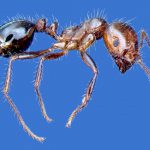
Red Imported Fire Ant. Photo Credit: University of Florida/IFAS
Size determines the lifespan of RIFA workers. Minor workers may live 30 to 60 days, media workers 60 to 90 days, major workers 90 to 180 days, and queens may live two to six years. Complete lifecycle from egg to adult takes between 22 and 38 days. RIFA are 1/8” to 1/4” long and reddish-brown or black in color.
RIFA usually respond rapidly and aggressively when disturbed. They clamp onto their victims with powerful jaws and sting repeatedly while injecting painful venom. The stings cause a burning sensation and itching blisters that can become infected. Although very uncommon, in severe cases, the stings can produce shock or cause death.
Where one can find RIFA
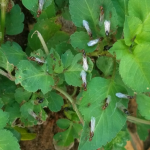
Winged alates preparing for nuptial flight. Photo Credit: Donna Arnold, University of Florida/IFAS Extension – Gadsden County
RIFA frequently invade home lawns, school yards, athletic fields, golf courses, parks, and other recreational areas. Additionally, electrical equipment and utility housing, home gardens, compost piles, mulched flowerbeds, pavement cracks, and the perimeter of bodies of water must all be considered when choosing a method of control.
Management
Two approaches can be taken to effectively manage RIFA.
- Single mound treatments
- Area-wide broadcast applications
Six methods of single mound treatment are available.
Mound Drenches. Large volumes of liquid toxic to ants are poured over a mound. Liquids can range from using several gallons of hot water to insecticides mixed with several gallons of water. This method may not reach the queen, therefore, not preventing colony elimination.
Surface Dusts. Similar to mound drenches, a dust or granular insecticide is applied over the top of the mound and then watered into the soil.
Mound Injections. The use of insecticides that may be pressurized and injected into a mound. Often this method is more expensive, but more effective, than mound drenches; however, more time may be required for this method.
Baits. Baits can be used for both individual mound and broadcast applications. A small amount of the bait is sprinkled around the mound and the ants then forage and bring the bait back to the colony to feed on. This method is slower acting, but more effective than drenching, dusting, or fumigating a mound because the workers will feed the bait to the queen and brood, thus gaining effective control of the colony.
Mechanical Control. Certain mechanical and electrical devices are on the market for controlling fire ants, but the efficacy has not been documented.
Home Remedies. Many homeowners will choose to pour boiling water or ignite flammable liquids over a mound. While these methods may bring about control, they are not recommended because they are both very dangerous, not only to humans, but also to the environment. Several other myths often circulate by the media or by way of word of mouth, often times these methods are anecdotal.
Area-wide broadcast applications
Currently, there are only a few products available for broadcast treatment of large areas. These products are either granular insecticides or baits composed of soybean oil and toxicant on a corn grit carrier. These granules are broadcast over a large area and are carried to the colony and fed to nestmates and the queen. This is a very effective application but does present problems because (1) ants may not find it, (2) do not feed upon the bait, and (3) some baits are light sensitive (as with hydramethylnon) and may inactivate before discovery by the ants. Reinfestation of any treated area, whether by broadcast treatment or individual mound treatment may occur.
As a result, other methods such as Biological Control is widely used to mitigate control of the RIFA.
Supporting information for this article can be found in the UF/IFAS EDIS publications (Managing Imported Fire Ants in Urban Areas) visit https://edis.ifas.ufl.edu/publication/lh059 and Red Imported Fire Ant, Solenopsis Invicta Buren (Insecta: Hymenoptera: Formicidae: Myrmicinae) https://edis.ifas.ufl.edu/publication/IN352.
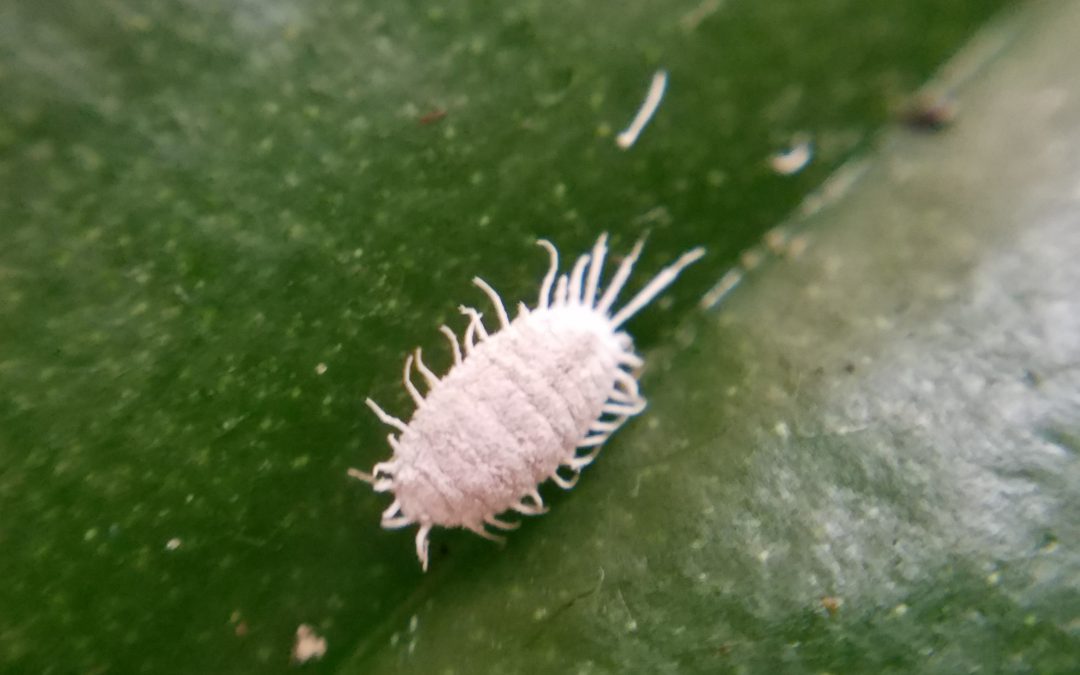
by Evan Anderson | Jun 24, 2021
There are lots of plant pests out there, and it can take a trained eye to tell which one is doing damage. Many of the insect pests that feed on crops and ornamentals have piercing-sucking mouthparts. These insects do not chew on leaves and leave holes behind; instead, they have a long stylus-like mouthpart they use like a straw to suck out plant juices. Over time this can weaken plants, cause irregular growth as damage builds up on new sprouts, introduce diseases to their hosts, and even cause mold to grow on leaves.
Because they drink so much fluid for their meals, many piercing-sucking insects exude a sugary liquid called honeydew. This liquid drops onto stems and leaves below which can leave them shiny and sticky. Eventually, the coating will grow a light greyish coating of sooty mold, which doesn’t do much harm to the plants itself but is a good indicator that you have an insect problem. You may also notice ants on your plants, working to harvest the honeydew for food. The ants don’t harm the plant, but following are some of the pests that do:
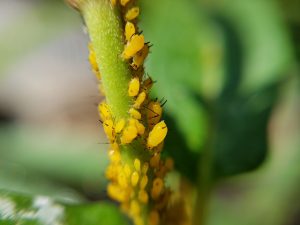
Aphids feeding on a plant stem.
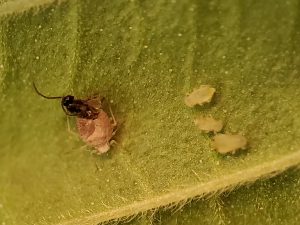
A parasitic wasp emerging from a dead aphid.
Aphids – Found on a wide variety of plants, aphids are fat-bodied little insects that often focus on new, tender growth. Their color depends on the plant they’re feeding on, and they can breed explosively. A female aphid does not need to mate to produce offspring, so a one can produce a lot of children very quickly. Look closely and you might be able to see their cornicles, which look like little tailpipes; these can help identify these pests. Luckily, we have some help in controlling aphids, as they are often parasitized by wasps. If you see large, swollen, brown aphids present, you probably have some wasps working for you.
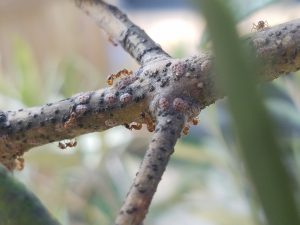
Ants tending some scale insects on a stem.
Scale Insects – Sometimes appearing to just be a bump on a stem or leaf, scale insects don’t move once they pick a plant to live on. Prolific producers of honeydew, some species grow a waxy shell which can protect them and make them difficult to deal with.
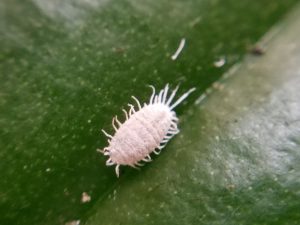
A mealybug.
Mealybugs – If you spy something white and fluffy living on stems or leaves, you might have mealybugs. Soft-bodied insects that are related to scales, they don’t move much. They feed on a wide range of host plants, but can effectively be controlled with a variety of methods once they’re found.

Whiteflies on the underside of a leaf.
Whiteflies – Not true flies, they are truly white in color. Tiny little members of the order Hemiptera (the same order that includes, aphids, scales, and mealybugs), they hang around the undersides of leaves. They enjoy warm weather and can become a problem in greenhouses. They are a bit more difficult to control than some of the other pests listed here.
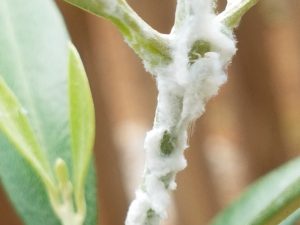
A psyllid nymph hiding in its waxy coating.
Psyllids and planthoppers – Small jumping insects that affect a variety of plant species, some are responsible for transmitting important plant diseases. Pierce’s disease of grapes and citrus greening, for example, are both vectored by these critters. Young nymphs sometimes secrete a waxy coating which may make them look similar to mealybugs.
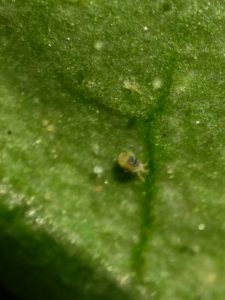
A tiny two-spotted spider mite.
Spider Mites – Not an insect but an arachnid, spider mites love hot, dry weather. Almost microscopic in size, the damage they do to leaves is often the first sign that they are present. Looking closely, one might notice tiny webbing where the mites live, or even the mites themselves on the undersides of leaves and on stems.
Many of these pests can be treated with a combination of methods. A sharp jet of water can dislodge some, hand removal can reduce populations even more, and products such as insecticidal soap or horticultural oils can finish them off. Insecticidal soaps are best used on soft-bodied insects such as aphids or mealybugs, while oils such as neem can help suffocate hard scales. Use products such as horticultural oil in the evening during hot weather to avoid damaging plant tissues with intense sunlight. Thorough coverage is important, as these products only control the pests they contact.
For more information on controlling insects, see our EDIS publications, such as Insect Management in the Home Garden or Landscape Integrated Pest Management.
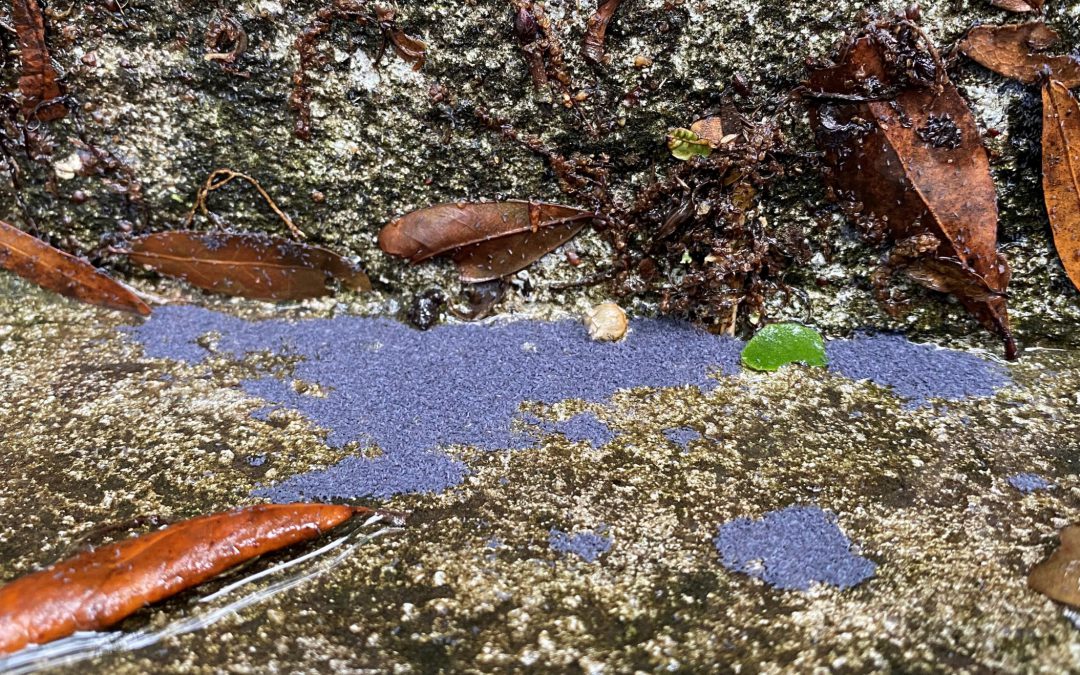
by Matt Lollar | Jun 17, 2021
A month or so ago I was leaving for work and I noticed a strange substance near the entrance to the house. The substance was blue and my first thought was crushed chalk from my kids writing on the sidewalk. Upon closer investigation I realized the substance was moving! It was now clear to me that the substance wasn’t chalk, but a congregation of insects. Naturally, I took pictures and collected a sample to bring into the county extension office…where I work. I looked at the insects under the microscope, but I wasn’t able to determine the species. So I sent some samples off to the University of Florida/IFAS Entomology and Nematology Department and the Florida Department of Agriculture and Consumer Services.
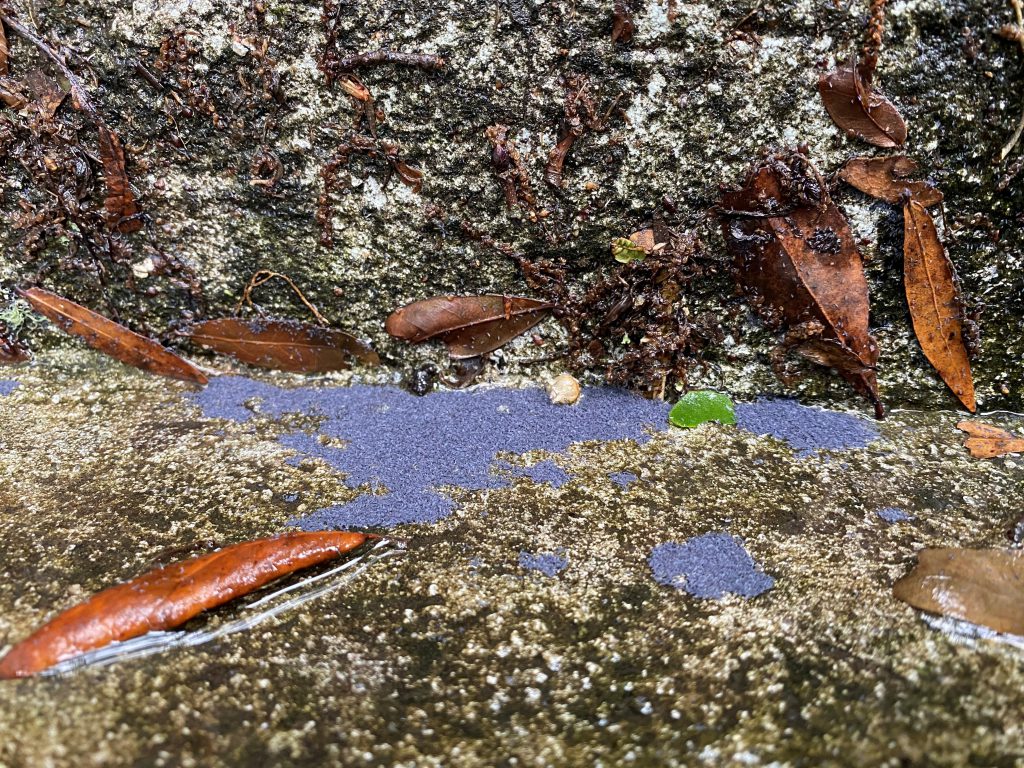
A swarm of Desoria flora on damp, outdoor steps. Photo Credit: Matt Lollar, University of Florida/IFAS Extension – Santa Rosa County
The experts identified the specimens as Desoria flora, a species of springtail insects endemic to Florida and originally described in Alachua County in 1980. Both entomologists thought it was unique the springtails were swarming. Springtails live in leaf litter and upper layers of soils. They are sometimes found in the potting mix of indoor and outdoor plants. Clients bring springtail specimens in to the office for identification from time to time. However, this was the first time I had seen them in a congregation.
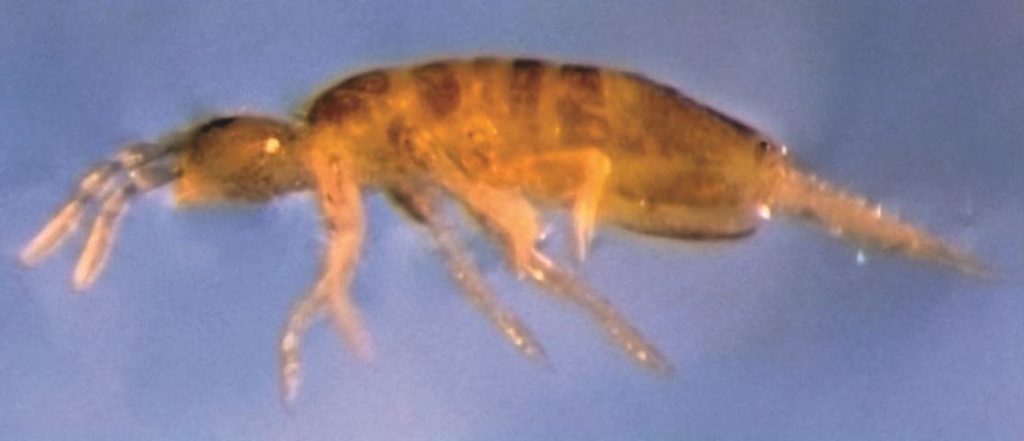
A linear springtail. Photo Credit: University of Florida/IFAS
If you find interesting insects, plants, or fungi and want them identified, please bring them into your local Extension Office. We’d be happy to help you identify the specimens. But sometimes we have to mail things off to a specialist.

by Evan Anderson | May 20, 2021
A number of landowners in our region have been noticing a number of caterpillars coming down from the treetops. Sometimes appearing in vast numbers, the forest tent caterpillar has been found throughout Florida and the United States. Several years of heavy infestation occurred in Central Florida more than a decade ago, but populations are usually not high enough to cause significant damage to trees.
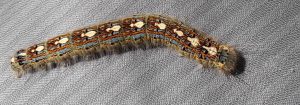
A forest tent caterpillar. – Photo courtesy of Shoal Sanctuary Nature Preserve.
The forest tent caterpillar is the larval stage of a somewhat nondescript brown moth. The moths lay their egg masses on twigs, and the eggs hatch in the spring. Caterpillars feed on a variety of tree species, but seem to prefer oak and gum trees. They spend anywhere from two to six weeks eating. When they are nearing maturity, they can become a problem for humans who do not appreciate the many droppings they produce, or their habit of descending from the trees to find places to spin their cocoons. They are sometimes attracted to lights or the walls of buildings, where they congregate in search of a place to pupate. They are not harmful to people, however.
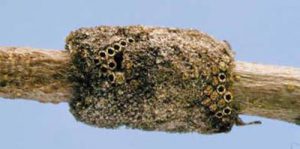
A forest tent caterpillar egg mass. – Photo courtesy of Jeffrey Lotz, Division of Plant Industry
Particularly cold winters may help decrease populations of these caterpillars. Inclement weather or high temperatures may do the same in the summer, and natural predators often help to control populations when present as well. Controlling forest tent caterpillars is most often unnecessary even when there are large numbers of them. It may help to avoid parking cars under large infestations or to turn off outdoor lighting that might attract them at night. If they wander indoors, check screens and window seals to be sure there are no gaps for them to enter.
If these or other caterpillars become such a nuisance that control measures must be considered, consider using a product such as Bacillus thuringiensis, or Bt, which specifically affects caterpillars and not other beneficial insects. Keep affected trees healthy with proper fertilization and watering, and even a defoliated tree will probably recover from any damage these insects cause. For more information, see our EDIS publication on the Forest Tent Caterpillar or contact your local Extension office.
-Evan Anderson, Walton County Horticulture Agent.
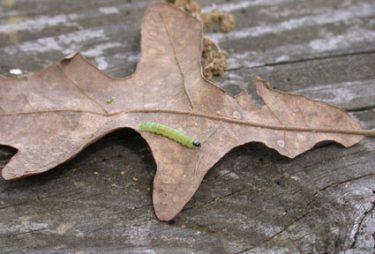
by Matt Lollar | Apr 1, 2021
If you’ve been raking leaves recently, you’ve probably noticed little green worms hanging from the trees. They seem to be in abundance this year and can be found crawling on driveways, just hanging around, and maybe even feeding on oak tree leaves.
These green worms that are all over the yard are oak leafrollers (Archips semiferanus) or oak leaftiers (Croesia semipurpurana). Some people may refer to them as inchworms, however a number of different caterpillars can go by that name. Leafrollers and leaftiers range in length from 1/4″ to 1″. The adult form of these insects is a 1/2″ long moth. The oak leafroller moth is mottled tan and brown and the oak leaftier moth is yellow with brown markings.
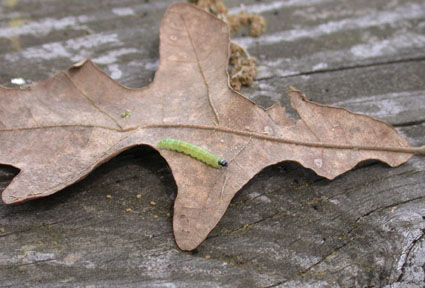
An oak leafroller caterpillar crawling on a leaf. Photo Credit: Blair Fannin, Texas A&M University
In May, the adults of both species lay their eggs in the twigs and leaf buds of a number of tree species. The eggs don’t hatch until March of the following year. When the caterpillars emerge, they feed on the newly forming leaves and flowers of oak, hackberry, pecan and walnut trees. If they are disturbed, they will stop feeding and hang from a strand of silk. Oak leafroller caterpillars pupate in tree branches, while oak leaftier caterpillars drop to the ground and pupate in leaf litter. Adult moths emerge in one to two weeks.
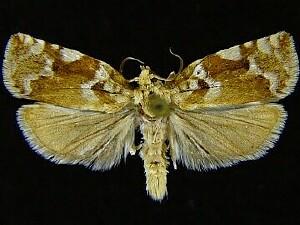
A leafroller moth with wings spread. Photo Credit: U.S. National Museum
The oak leafrollers and oak leaftiers don’t really do enough damage to be considered pests, but they are a bit of a nuisance. Thankfully, birds and parasitic wasps will eat and kill the majority of the population. For in-depth information on most of the interesting insects in your yard, please visit the UF/IFAS Featured Creatures Website.





















